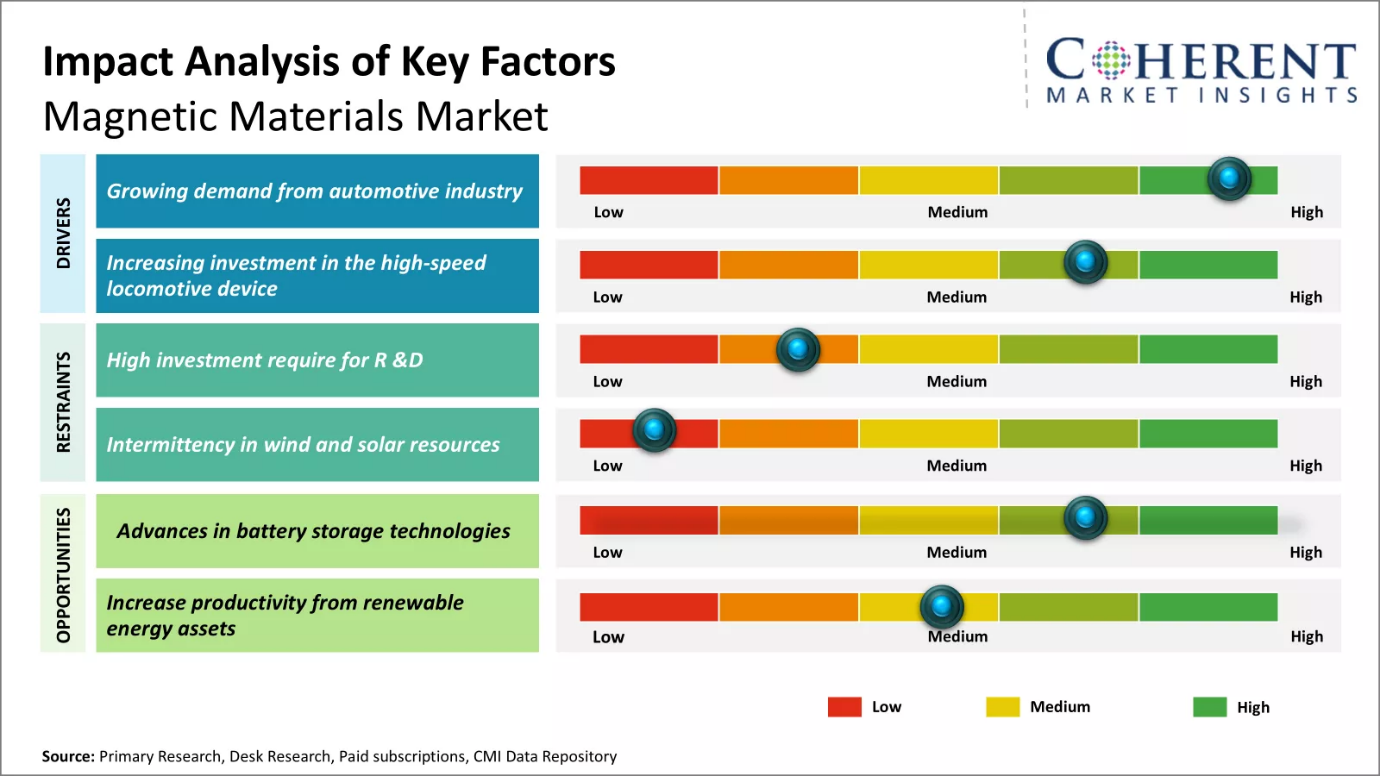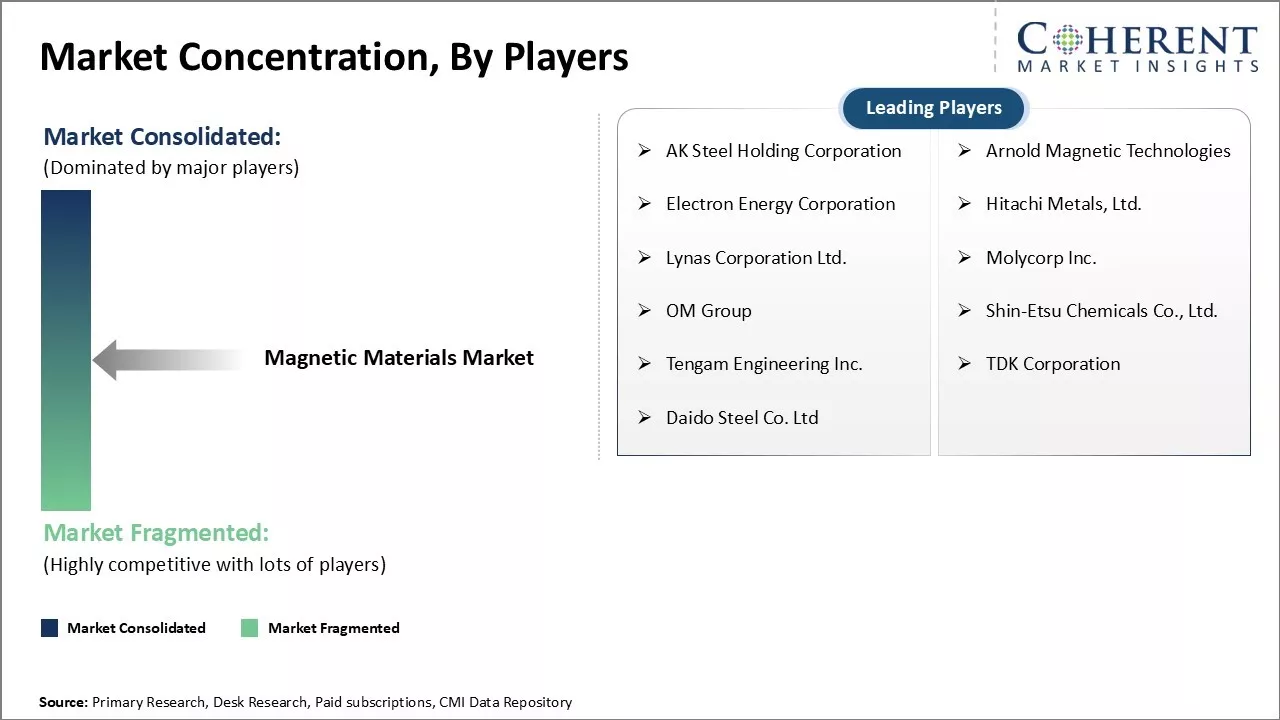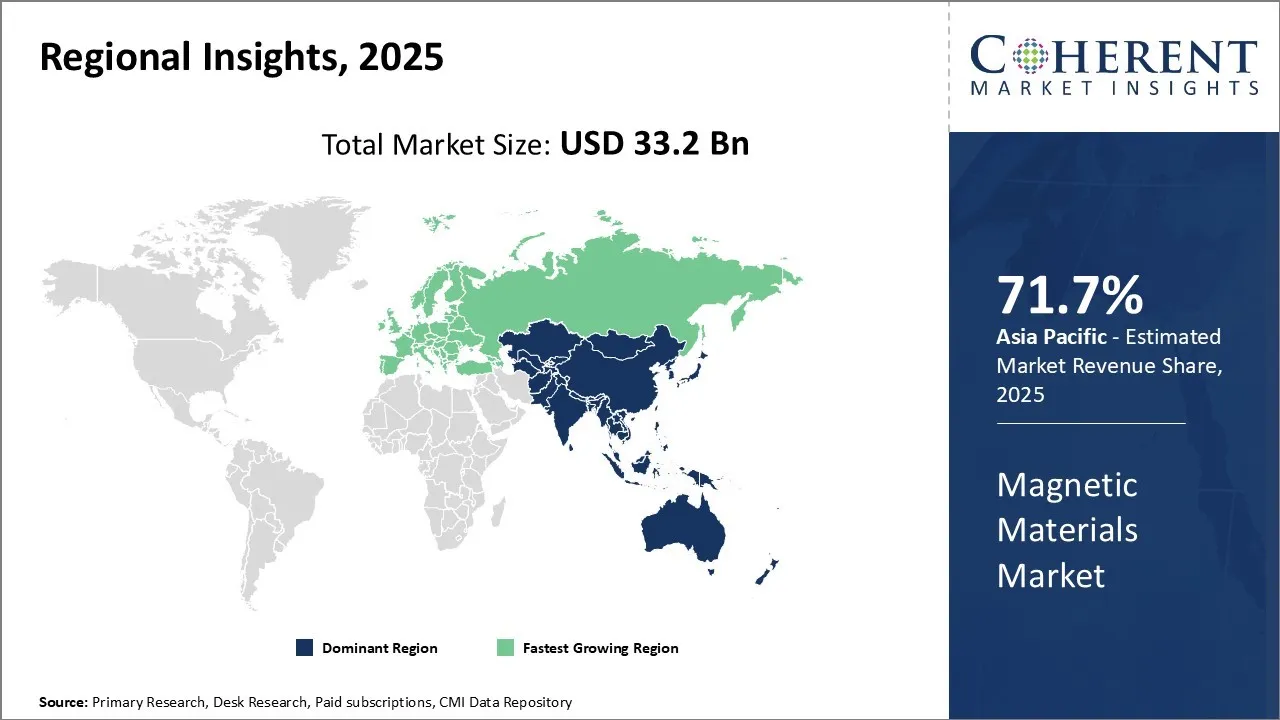The magnetic materials market is estimated to be valued at USD 33.20 Bn in 2025 and is expected to reach USD 48.98 Bn by 2032, exhibiting a compound annual growth rate (CAGR) of 5.7% from 2025 to 2032.

To learn more about this report, Download Free Sample
Factors such as the increasing use of magnetic materials across various end-use industries including automotive and electric & electronics among others can drive the market growth. Furthermore, growing demand for electric vehicles and focus on energy efficient products can also drive the market growth. Wide application in motors, transformers, generators, and various other electromagnetic applications boosts demand for magnetic materials.
However, challenges such as fluctuating raw material prices and supply chain disruptions, which can impact production costs and availability.

To learn more about this report, Download Free Sample
|
Current Events |
Description and its impact |
|
China’s Rare Earth Export Restrictions |
|
|
U.S.-China Trade Negotiations and Tariffs |
|
Uncover macros and micros vetted on 75+ parameters: Get instant access to report
The rising adoption of electric vehicles (EVs) and hybrid vehicles is significantly propelling the demand for advanced magnetic materials—a trend that is reshaping both the automotive and materials sectors. Magnetic materials such as neodymium-iron-boron (NdFeB) and ferrites play a critical role in the manufacturing of electric motors and generators, which are essential components of EV powertrains.
For instance, according to the International Energy Agency, global electric car sales are expected to increase by 25% in 2025. This surge is not only transforming the automotive industry but also driving innovation and growth in the advanced materials sector.
In terms of product type, soft magnetic materials segment is estimated to contribute the highest market share of 49.6% in 2025, owing to their widespread applications.
Soft magnetic materials such as iron, cobalt, and nickel are highly suitable for applications that require magnetic properties along with good electrical conductivity. These materials have low coercivity, which allows them to easily switch magnetic alignment or polarization when exposed to an external magnetic field. Their low retentivity enables them to lose magnetic polarization when the external field is removed.
In terms of application, automotive & transportation segment is estimated to contribute the highest market share of 29.8% in 2025.
Automotive industry is undergoing rapid electrification with a growing focus on developing electric and hybrid vehicles. This transition towards electrification boosts demand for magnetic materials from the automotive sector. Electric vehicles utilize various magnetic components such as electric motors that require core materials with soft magnetic properties.
The magnetic materials market, essential for sectors ranging from electronics to renewable energy, is undergoing a transformative shift driven by artificial intelligence (AI). By integrating AI into their operations, companies are innovating product design, enhancing application efficiency, and delivering superior value to end users. This convergence is redefining industry standards and unlocking new growth avenues.

To learn more about this report, Download Free Sample
Asia Pacific is projected to hold the largest revenue share 71.7% of the global magnetic materials market in 2025. This regional dominance is attributed to its robust manufacturing and industrial sectors, which heavily rely on magnetic materials. Additionally, government support for research and development, along with partnerships between research institutions and industry stakeholders, has fostered ongoing advancements in the field.
For instance, according to the Oxford Institute for Energy Studies, China is currently the only major producer of heavy rare earth elements, which are critical for the production of high-performance permanent magnets. Although China holds only about 15% (or possibly less than 10%) of the world’s geological reserves of heavy rare earths, it accounts for approximately 70% of annual global mine output and 90% of global processing and refining capacity.
The Europe magnetic materials market is experiencing rapid growth, driven by expanding end-use industries such as consumer electronics, automotive, and healthcare, particularly in emerging economies. Supportive policies are encouraging domestic manufacturing and enhancing regional production capabilities. Additionally, foreign investments are boosting capacity and fostering new product development across the region.
For instance, according to the European Institute of Innovation & Technology (EIT), the European Raw Materials Alliance (ERMA) has identified investment opportunities spanning the entire value chain—from rare earth mining and urban mining to magnet production. These projects are distributed across Europe and represent a total investment volume of approximately USD 1.87 billion. The aim is to enable the European Union to meet 20% of its rare earth magnet needs by 2030—15 times more than current levels.
China’s dominance in the magnetic materials market stems from its extensive control over rare earth mining and processing. The country’s focus on expanding its manufacturing base for electric vehicles and renewable energy technologies has intensified the demand for high-performance magnetic materials. Government initiatives supporting technological innovation and infrastructure development further bolster China’s leading position in this sector.
For instance, as per the NITI AYOG, global output of mined graphite is highly concentrated with China accounting for almost three-fifths (59.1%).
Japan drives the magnetic materials market through its strong emphasis on advanced electronics and automotive industries. The country’s commitment to developing energy-efficient technologies and hybrid vehicles relies heavily on specialized magnetic materials. Continuous investment in research and development enables Japan to innovate in magnetic materials, ensuring high-quality and sustainable supply chains.
Supporting this innovation ecosystem, the 28th International Workshop on Rare Earth and Future Permanent Magnets and Their Applications (REPM2025) is scheduled to be held from July 27 to 31, 2025, in Tsukuba, Japan, highlighting Japan’s central role in advancing rare earth and magnetic materials technologies.
Germany’s growth in the magnetic materials market is fueled by its robust automotive and industrial machinery sectors. As a pioneer in electric mobility and renewable energy integration, Germany requires sophisticated magnetic materials for electric motors and generators. Government policies encouraging green technologies and industrial digitization enhance the demand for advanced magnetic solutions.
India’s expanding industrial base and increasing focus on renewable energy are contributing to a growing demand for magnetic materials. The country is enhancing its domestic production capabilities and promoting partnerships to reduce dependency on imports. Additionally, infrastructure development and the rising adoption of electric vehicles are key drivers of the market growth in India.
According to Autocar Professional, as of July 2025, India sourced over 80% of its approximately 540 tons of magnet imports from China during the previous fiscal year.
| Report Coverage | Details | ||
|---|---|---|---|
| Base Year: | 2024 | Market Size in 2025: | USD 33.20 Bn |
| Historical Data for: | 2020 To 2024 | Forecast Period: | 2025 To 2032 |
| Forecast Period 2025 to 2032 CAGR: | 5.7% | 2032 Value Projection: | USD 48.98 Bn |
| Geographies covered: |
|
||
| Segments covered: |
|
||
| Companies covered: |
AK Steel Holding Corporation, Arnold Magnetic Technologies, Electron Energy Corporation, Hitachi Metals, Ltd., Lynas Corporation Ltd., Molycorp Inc., OM Group, Shin-Etsu Chemicals Co., Ltd., Tengam Engineering Inc., TDK Corporation, and Daido Steel Co. Ltd |
||
| Growth Drivers: |
|
||
| Restraints & Challenges: |
|
||
Uncover macros and micros vetted on 75+ parameters: Get instant access to report
*Definition: The magnetic materials market encompasses the production, distribution, and application of materials that exhibit magnetic properties, such as ferromagnetism or paramagnetic. These materials—including types like neodymium magnets, ferrites, and alnico—are essential components in various industries, powering devices such as electric motors, generators, sensors, data storage, and electronics. The market covers raw material sourcing, manufacturing processes, and end-use sectors like automotive, electronics, healthcare, and renewable energy.
Share
Share
About Author
Yash Doshi is a Senior Management Consultant. He has 12+ years of experience in conducting research and handling consulting projects across verticals in APAC, EMEA, and the Americas.
He brings strong acumen in helping chemical companies navigate complex challenges and identify growth opportunities. He has deep expertise across the chemicals value chain, including commodity, specialty and fine chemicals, plastics and polymers, and petrochemicals. Yash is a sought-after speaker at industry conferences and contributes to various publications on topics related commodity, specialty and fine chemicals, plastics and polymers, and petrochemicals.
Missing comfort of reading report in your local language? Find your preferred language :
Transform your Strategy with Exclusive Trending Reports :
Frequently Asked Questions
Joining thousands of companies around the world committed to making the Excellent Business Solutions.
View All Our Clients